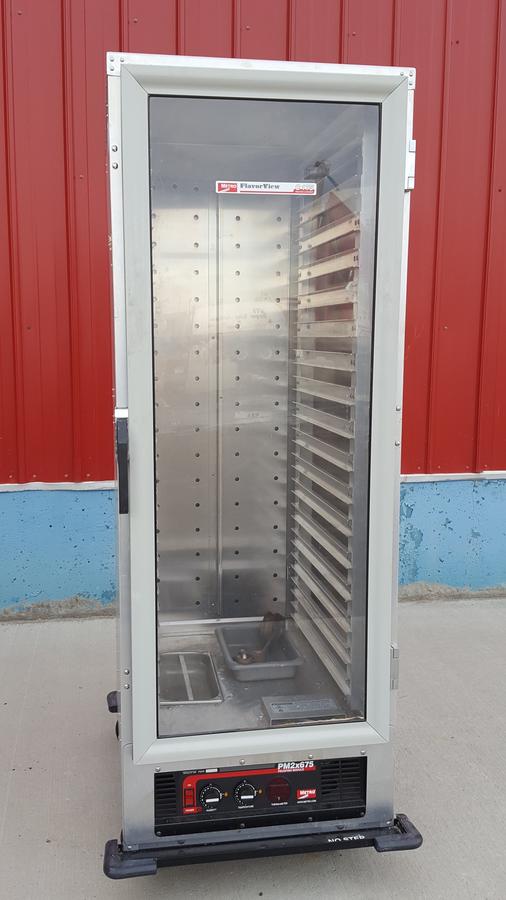Hello fellow Smoke Lovers,
I have finally started on a conversion project after pondering several types of builds. I have obtained a full functioning InterMetro Food Proofer. The inside measurements of the cabinet are 56" high, 24" wide and 29" deep. It has two 675 watt heating elements inside of it. One is used to heat a water pan to control humidity and the other is used to heat the inside circulating air that is blown with a small squirrel cage fan. This fan can be run independently with out any of the heat sources on.
The cabinet is between 23 and 24 cubic feet. I have built 11 rack of regular mild steel expanded metal (Stainless was WAY to expensive) that are 18" x 24", so have 4752 sq inches of rack space if all are utilized. The unit will primarily be used for smoking jerky and sausage.
I would like to go with an Auber PID controller WSD-1501-GPH and use another heating element to keep the unit fully electric and would like to keep it 110 volt. I spoke with a guy from Auber yesterday and he was very helpful and provided me with a lot of information. I was told that this controller can handle an element up to 1800 watts.
The building where the smoker will be kept has next to no electrical load in it and the breaker panel is still pretty much empty, so if i need to I can install 20 amp or bigger breakers and run the appropriately sized wire so that the proofer and PID can be plugged into separate outlets.
I was thinking of using the water pan as my chip tray and use the element as my heat source.
With the size of my cabinet if I add a 1500 to 1800 watt element combined with the existing 1350 watts will that be enough to heat the cabinet to say around 250-300 degrees F and be able to recover temps in a timely fashion? I was also thinking of using charcoal briquettes or some lump charcoal if a bit more heat is needed.
As for the fan that is currently in the warmer, I plan to keep utilizing it to circulate the air inside to maintain even cooking temps inside. I was thinking of installing a rheostat control so that i can be variable speed.
I need to install a chimney and was planning on a 4" pipe with a damper in it.
I would welcome any comments or suggestions that may assist me with the build. It is going to be utilized to make plenty of delicious salted cured meats so I do not mind investing some cash into it.
Thanks, may your smoke be thin and blue.
I have finally started on a conversion project after pondering several types of builds. I have obtained a full functioning InterMetro Food Proofer. The inside measurements of the cabinet are 56" high, 24" wide and 29" deep. It has two 675 watt heating elements inside of it. One is used to heat a water pan to control humidity and the other is used to heat the inside circulating air that is blown with a small squirrel cage fan. This fan can be run independently with out any of the heat sources on.
The cabinet is between 23 and 24 cubic feet. I have built 11 rack of regular mild steel expanded metal (Stainless was WAY to expensive) that are 18" x 24", so have 4752 sq inches of rack space if all are utilized. The unit will primarily be used for smoking jerky and sausage.
I would like to go with an Auber PID controller WSD-1501-GPH and use another heating element to keep the unit fully electric and would like to keep it 110 volt. I spoke with a guy from Auber yesterday and he was very helpful and provided me with a lot of information. I was told that this controller can handle an element up to 1800 watts.
The building where the smoker will be kept has next to no electrical load in it and the breaker panel is still pretty much empty, so if i need to I can install 20 amp or bigger breakers and run the appropriately sized wire so that the proofer and PID can be plugged into separate outlets.
I was thinking of using the water pan as my chip tray and use the element as my heat source.
With the size of my cabinet if I add a 1500 to 1800 watt element combined with the existing 1350 watts will that be enough to heat the cabinet to say around 250-300 degrees F and be able to recover temps in a timely fashion? I was also thinking of using charcoal briquettes or some lump charcoal if a bit more heat is needed.
As for the fan that is currently in the warmer, I plan to keep utilizing it to circulate the air inside to maintain even cooking temps inside. I was thinking of installing a rheostat control so that i can be variable speed.
I need to install a chimney and was planning on a 4" pipe with a damper in it.
I would welcome any comments or suggestions that may assist me with the build. It is going to be utilized to make plenty of delicious salted cured meats so I do not mind investing some cash into it.
Thanks, may your smoke be thin and blue.

















